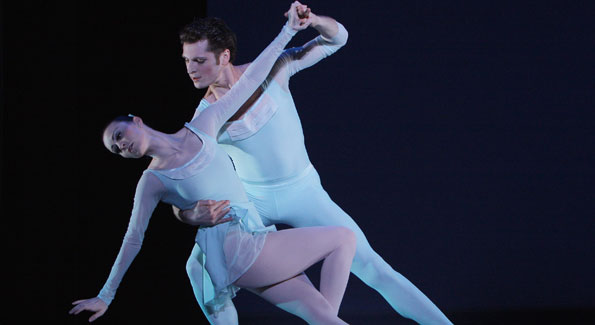Suzanne Farrell, the celebrated Balanchine muse, claims her own artistic voice.
By Dawn Lim

Elisabeth Holowchuk and Kirk Henning. Photo by Carol Pratt
When she first stepped into the limelight in the 1960’s, Suzanne Farrell did to American ballet what Twiggy did to the fashion model: She gave birth to the cult of the ballerina. Farrell wove around herself the mythology of a ballerina of long, extended lines, as New York City Ballet choreographer George Balanchine orchestrated her rise as a ballet icon. Would Suzanne Farrell have been Suzanne Farrell without Balanchine? Thirty years after his death, Balanchine’s artistic and romantic muse revisited the pieces he created for her at the Kennedy Center, creating a portrait of a dancer indebted to Balanchine but firmly in possession of her own artistic voice.
Performed by the Suzanne Farrell Ballet on March 3 at the Kennedy Center, “Apollo” seemed to be a tribute to male prowess – and yet not quite. In the piece, Apollo (Michael Cook) reached out to the three muses (Natalia Magnicaballi, Kendra Mitchell, Violeta Angelova) seated below him. They raised beautifully arched feet towards him, like chariot horses submitting to his will. But as the quartet began ringing around one another with arms interlinked in a daisy chain, Apollo revealed himself not a master but a collaborator. Then, in a burst of collective energy, the group struck up the image of a powerful sun. The muses’ extended arabesques of different heights were perfectly balanced in the other direction by Apollo’s outstretched arms. It was a glorious image of the brilliance produced by different bodies that draw out one another’s strengths.
An articulation of Farrell’s artistic autonomy, “Haieff Divertimento” depicted an elusive muse who cannot be possessed. In the piece, Elisabeth Holowchuk circled her legs in self-satisfied rond de jambes, acknowledging the overtures of Kirk Henning with clinical detachment. Henning’s soaring lines contrasted with the angular and geometric movements of the partners surrounding him. The piece was signature Balanchine: a choreography of contrasts, dance that contrasts aching expressiveness and deadpan formalism. But in the piece, Henning’s partner was happier when left to her own devices (reminiscent of the early Farrell who married another dancer, defying Balanchine?) In a solo, Holowchuk experimented with different centers of gravity, shifting her legs front, center and back, discovering the miracle of her own body.
In “Afternoon of a Faun,” choreographed not by Balanchine, but Jerome Robbins, a muse loves herself too much to submit to another. A girl (Natalia Magnicaballi) stepped into a dance studio where a man (Michael Cook) was aching and turning on the floor in a dream. Pivoting and pirouetting, Manicaballi luxuriated in her own lightness, flaunting both innocence and sexuality. She let herself be led and lifted; but once kissed, she receded in the background. Like Farrell, she was leaving behind the teasing promise of another visitation – and carving out the overwhelming sense of her own invisible presence.




